Pseudoscorpions of Israel: Annotated Checklist and Key, with New Records of Two Families (Arachnida: Pseudoscorpiones)
Abstract
1. Introduction
2. Materials and Methods
3. Results
3.1. Systematics and Taxonomy
3.1.1. Figures and Tables
| Family | Species | Global Zoogeographic Category | Chorotype | Chorological Complex |
|---|---|---|---|---|
| Atemnidae | ||||
| Atemnus sp. * | Palearctic and Afrotropic | OLD | Widely distributed | |
| Atemnus syriacus (Beier, 1955) ¢ [16] | Palearctic | EMED | Mediterranean | |
| Cheiridiidae * | ||||
| Apocheiridium sp. * | Palearctic | COS | Widely distributed | |
| Cheliferidae | ||||
| Chelifer cancroides (Linnaeus, 1758) [15] | Palearctic and Afrotropic | COS | Widely distributed | |
| Chelifer cancroides cancroides (Linnaeus, 1758) ¢ [1] | Palearctic and Afrotropic | COS | Widely distributed | |
| Dactylochelifer kussariensis (Daday, 1889) [15] | Palearctic | CWA | Asian | |
| Dactylochelifer kussariensis kussariensis (Daday, 1889) ¢ [1] | Palearctic | CWA | Asian | |
| Dactylochelifer pallidus Beier, 1963 e, T [15] | Endemic (Palearctic origin) | END | Endemic | |
| Hysterochelifer cyprius (Beier, 1929) [15] | Palearctic | EMED | Mediterranean | |
| Hysterochelifer distinguendus (Beier, 1929) e [26] | Endemic (Palearctic origin) | END | Endemic | |
| Hysterochelifer gracilimanus Beier, 1949 ¢ [17] | Palearctic | EMED | Mediterranean | |
| Hysterochelifer tuberculatus (Lucas, 1849) [15] | Palearctic | MED | Mediterranean | |
| Hysterochelifer tuberculatus tuberculatus (Lucas, 1849) ¢ [1] | Palearctic | MED | Mediterranean | |
| Rhacochelifer corcyrensis (Beier, 1930) ¢ [17] | Palearctic | MED | Mediterranean | |
| Rhacochelifer corcyrensis bicolor Beier, 1963 T [15] | Palearctic | LEV | Mediterranean | |
| Rhacochelifer corcyrensis corcyrensis (Beier, 1930) ¢ [17] | Palearctic | EMED | Mediterranean | |
| Rhacochelifer lobipes (Beier, 1929) [15] | Palearctic | EMED | Mediterranean | |
| Rhacochelifer longeunguiculatus Beier, 1963 T [15] | Afrotropic | APA | Afrotropic | |
| Rhacochelifer maculatus (L. Koch, 1873) [17] | Palearctic | MED | Mediterranean | |
| Rhacochelifer peculiaris (L. Koch, 1873) [1] | Palearctic | SEM | Mediterranean | |
| Rhacochelifer peculiaris latissimus Beier, 1963 T [15] | Palearctic | EMED | Mediterranean | |
| Chernetidae | ||||
| Allochernes masi (Navás, 1923) [15] | Palearctic | MED | Mediterranean | |
| Chernes rhodinus Beier, 1966 [16] | Palearctic | EMED | Mediterranean | |
| Chernes sp. * | Palearctic | HOL | Widely distributed | |
| Lamprochernes nodosus (Schrank, 1803) [15] | Palearctic and Afrotropic | OLD | Widely distributed | |
| Lamprochernes nodosus nodosus (Schrank, 1803) ¢ [1] | Palearctic and Afrotropic | OLD | Widely distributed | |
| Lamprochernes savignyi (Simon, 1881) [15] | Afrotropic | COS | Widely distributed | |
| Lasiochernes turcicus Beier, 1949 [15] | Palearctic | EMED | Mediterranean | |
| Nudochernes spalacis Beier, 1955 e, T [27] | Endemic (Afrotropic origin) | END | Endemic | |
| Pselaphochernes scorpioides (Hermann, 1804) ¢ [16] | Palearctic | HOL | Widely distributed | |
| Chthoniidae | ||||
| Ayyalonia dimentmani Ćurčić, 2008e [13] | Endemic (Afrotropic origin) | END | Endemic | |
| Chthonius jonicus Beier, 1931 ¢ [16] | Palearctic | MED | Mediterranean | |
| Chthonius shulovi Beier, 1963 e ¢ [15] | Endemic (Palearctic origin) | END | Endemic | |
| Chthonius sp. * | Palearctic | COS | Widely distributed | |
| Ephippiochthonius sacer (Beier, 1963) e, T [15] | Endemic (Palearctic origin) | END | Endemic | |
| Ephippiochthonius tetrachelatus (Preyssler, 1790) [15] | Palearctic | COS | Widely distributed | |
| Ephippiochthonius spp. * | Palearctic | COS | Widely distributed | |
| Garypidae | ||||
| Garypus beauvoisii (Audouin, 1826) [15] | Palearctic | MED | Mediterranean | |
| Garypus levantinus Navás, 1925 [15] | Palearctic | MED | Mediterranean | |
| Garypinidae | ||||
| Garypinus asper Beier, 1955 [16] | Palearctic | EMED | Mediterranean | |
| Garypinus dimidiatus (L. Koch, 1873) [15] | Palearctic | EMED | Mediterranean | |
| Geogarypidae | ||||
| Geogarypus pulcher Beier, 1963 e, T [15] | Endemic (Palearctic origin) | END | Endemic | |
| Geogarypus shulovi Beier, 1963 T [15] | Palearctic | CWA | Asian | |
| Hesperolpiidae | ||||
| Calocheirus atopos Chamberlin, 1930 T [15] | Afrotropic | APA | Afrotropic | |
| Cardiolpium stupidum (Beier, 1963) T [15] | Palearctic | EMCA | Euro-Asia | |
| Menthidae | ||||
| Paramenthus shulovi Beier, 1963 e, T [15] | Endemic (Afrotropic origin) | END | Endemic | |
| Neobisiidae | ||||
| Neobisium (Neobisium) validum (L. Koch, 1873) [15] | Palearctic | EMCA | Euro-Asia | |
| Neobisium sp. * | Palearctic | EMCA | Euro-Asia | |
| Olpiidae | ||||
| Calocheiridius libanoticus Beier, 1955 [15] | Palearctic | EMWA | Mediterranean | |
| Halominniza aegyptiaca (Ellingsen, 1910) ¢ [1] | Palearctic | EMED | Mediterranean | |
| Halominniza aegyptiaca litoralis (Beier, 1963) [15] | Palearctic | LEV | Mediterranean | |
| Minniza babylonica Beier, 1931 [15] | Palearctic and Afrotropic | CWAP | Asian | |
| Minniza babylonica babylonica Beier, 1931 ¢ [1] | Palearctic and Afrotropic | CWAP | Asian | |
| Minniza lindbergi Beier, 1957 [15] | Palearctic | EMED | Mediterranean | |
| Olpium kochi Simon, 1881 [28] | Palearctic | EMED | Mediterranean | |
| Olpium pallipes (Lucas, 1849) [26,27] | Palearctic | MCA | Mediterranean | |
| Olpium pallipes balcanicum Beier, 1931 [15] | Palearctic | EMED | Mediterranean | |
| Olpium pallipes pallipes (Lucas, 1849) ¢ [1] | Palearctic | MCA | Mediterranean | |
| Syarinidae * | ||||
| Hadoblothrus sp. * | Palearctic | EMED | Mediterranean | |
| Withiidae | ||||
| Nannowithius wahrmani (Beier, 1963) e, T [15] | Endemic (Afrotropic origin) | END | Endemic | |
3.1.2. The Pseudoscorpion Families
- Cheliferidae is the largest and most common family deposited in the NNHC HUJ collection. Four genera and eighteen species and subspecies are documented from Israel (Table 3, Figure 4a,b). Only one species is Afrotropical; the rest are Palearctic, with eleven Mediterranean, two Asian, two cosmopolitan and two endemic species (Table 3). Cheliferids were collected all over the country, in all regions except the Hermon (Figure 3 and Figure 4a,b) and all year round. Most Cheliferids were collected in spring and summer, and fewer individuals were collected in autumn and winter (Figure 5A). Cheliferids were collected using all methods. They were often found under bark and in leaf litter (Figure 5B) usually in habitats with trees. The subspecies Rhacochelifer corcyrensis bicolor Beier, 1963, was found almost exclusively in the desert, mainly on Acacia trees (Vachellia Wight & Arn) using trunk traps (Figure 4a,b and Figure 5A,C). The cosmopolitan species Chelifer cancroides (Linnaeus 1758) is phoretic and often found in beehives. The genus Dactylochelifer Beier, 1932, (the species D. kussariensis (Daday, 1889) and the endemic species D. pallidus Beier, 1963) was typically found near wetlands (swamps and riverbanks) (Figure 4a and Figure 5A). The other endemic cheliferid Hysterochelifer distinguendus (Beier, 1929) was found only in the Judean Foothills (Figure 4a). Several specimens of Rhacochelifer longeunguiculatus Beier, 1963, as well as unidentified species, were collected from cave entrances but no troglobiont species have been recorded from Israel thus far (Figure 6A).
- Olpiidae is the second largest and most common family deposited in the NNHC HUJ collection, both in number of specimens and number of species and subspecies. Four genera and ten species are documented from Israel (Table 3, Figure 4c). Although, globally, Olpiidae species are usually found in xeric habitats (desert and semi-desert), the species in Israel are mostly Palearctic, with eight species from the Mediterranean and two species from Central and Western Asia and the Arabian Peninsula, thus from both Palearctic and Afrotropic regions (Table 3). Olpiids were collected throughout Israel in all regions except the Hula Valley, but they were significantly more common in the desert, where more than 75% of the specimens were found, whereas less than 10% were found in all the northern regions of Israel and the coastal plain (Supplementary Materials Tables S2 and S3). They were collected all year, but the highest number was collected during spring and the lowest during winter (Figure 5A). Specimens were collected by visual search under stones, sifting and in pitfall traps (Figure 5C). None of the olpiid species are endemic to Israel, though Halominniza aegyptiaca litoralis (Beier, 1963) is endemic to the southern Levant (Israel, Jordan and Sinai), and was found in Israel only in the desert near the Dead Sea and the Red Sea, in association with sea (salty) water (Figure 4c). The Asian species Minniza babylonica Beier, 1931, which is found in both Palearctic and Afrotropic regions, is typically found in Israel in the desert (Figure 4c). This family has not been recorded from caves or moist epigean habitats (Figure 6B).
- Chernetidae is the third largest and most common family deposited in the NNHC HUJ collection in both number of specimens and number of species, with six genera and eight species, in addition to undescribed species from caves. Five of these species are widely distributed and three are Mediterranean, whereas one is endemic from an Afrotropical origin (Table 3, Figure 4d). Most of the specimens (80%) were collected in the mountains of central Israel and the Jezreel valley, while hardly any were collected in the desert (Figure 4d, Supplementary Materials Tables S2 and S3). Chernetids were found evenly throughout the year (Figure 5A) and usually by visual search (Figure 5C). Species of Chernetidae are often phoretic on rodents or insects (Figure 5B) and tend to aggregate in their nests as evidenced by 80% of the family’s specimens in Israel: Lamprochernes savignyi (Simon, 1881) is phoretic on flies, Lasiochernes turcicus Beier, 1949, (Figure 6C) is found in nests of Apodemus Kaup, 1829, and Nudochernes spalacis Beier, 1955, in nests of Nannospalax species. Nearly half of the specimens collected from caves in Israel (44%) belonged to the Chernetidae family, being a quarter of the family’s specimens collected in Israel, from the species Allochernes masi, Chernes rhodinus, Lasiochernes turcicus and other unidentified species (Figure 5B). They were found mainly in caves with bats, both frugivorous and insectivorous, and L. turcicus also in an Apodemus nest.
- Neobisiidae is the fourth most common family deposited in the NNHC HUJ collection in terms of number of specimens. However, it is represented in Israel with only one genus and one species throughout the country, the Palearctic Neobisium validum (L. Koch, 1873) (Figure 6D), which is found in the East-Mediterranean, as well as Central and Western Asia (Table 3, Figure 4e), with the type locality in Syria. Only 4% of the specimens were collected from the desert, while 93% were collected in the mountains of north and central Israel and the Jezreel valley (Figure 4e, Supplementary Materials Tables S2 and S3). The remaining 3% were collected in the coastal region. Preliminary DNA sequencing (not presented here) indicates a species complex, which needs to be examined further. As a hygrophilous family, Neobisiidae specimens were collected four times more in winter than in spring and autumn, while none were collected during the summer (Figure 5A). They were usually found by sifting soil and leaf litter, visual search under stones or using pitfall traps (Figure 5B,C). One specimen of a presently unidentified troglobitic species was found in a cave.
- Chthoniidae is represented in Israel by five species from three genera in addition to several undescribed species from caves. Three species are endemic, one Mediterranean and one cosmopolitan (Table 3, Figure 4f). Chthoniids were found exclusively in the mountains of north and central Israel (Figure 3, Figure 4f, Supplementary Materials Tables S2 and S3) or in caves (Figure 5B). Half of the pseudoscorpion specimens we found in Israel’s caves belonged to the Chthoniidae, representing 75% of the family’s specimens collected in Israel. Being a family with high short-range endemism [6], we expect to reveal several new species among the unidentified cave specimens (Figure 6E). As a hygrophilous family, only a few Chthoniidae specimens were collected in the driest season in Israel, autumn (Figure 5A). Chthoniids were collected mostly by visual search under stones, and on bat guano in caves (Figure 5B,C), but they also occur in leaf litter, and some were collected by sifting and pitfall traps. Ayyalonia dimentmani Ćurčić, 2008, is an example of an endemic relict species found only in a single unique chemoautotrophic cave. Another endemic species, Chthonius shulovi Beier, 1963, was found only once in one locality in Wadi Qelt [15]. Both species were never found again. However, the endemic species Ephippiochthonius sacer (Beier, 1963) seems to be more widespread, and was found several times in the Mediterranean region of north and central Israel.
- Garypinidae is represented in Israel by two species of Garypinus Dadday, 1889, which have an eastern Mediterranean to Palearctic distribution (Table 3, Figure 4g). Both were found exclusively in the mountains of north and central Israel (Figure 3 and Figure 4g, Supplementary Materials Tables S2 and S3), mostly in spring and summer (Figure 5A), often by sifting leaf litter or visual search under stones (Figure 5B,C).
- Garypidae is represented in Israel by two species of Garypus L. Koch, 1873, which are halophilous and widespread in seashore habitats of the Mediterranean (Table 3, Figure 4h). Both were found in all seasons but winter (Figure 5A), exclusively in the salty habitat of the Mediterranean coast (Figure 3, Figure 4h and Figure 5B). Some specimens were found in algae debris at the coastline.
- Geogarypidae is represented in Israel by two species of Geogarypus Chamberlin, 1930: Geogarypus shulovi Beier, 1963, is Palearctic from Central and Western Asia, and Geogarypus pulcher Beier, 1963, is endemic to Israel (Table 3, Figure 4h). Most of the specimens were found in the mountains of north and central Israel, but some were also found in the coastal plain and Hula valley (Figure 3, Figure 4h and Figure 5B, Supplementary Materials Tables S2 and S3). They were usually found by sifting leaf litter, mostly in spring (Figure 5B,C).
- Hesperolpiidae is represented in Israel by two species from two genera: Calocheirus atopos Chamberlin, 1930, is Afrotropic from the Arabian Peninsula and Sudan, and Cardiolpium stupidum (Beier, 1963) is Palearctic from East-Mediterranean and Central-West Asia (Table 3, Figure 4h). They are found mostly in spring (Figure 5A), in small numbers but in a wide distribution along Israel (Figure 3, Figure 4h and Figure 5B).
- Menthidae is an infrequently collected family and represented in our collection by only three specimens; all belong to the endemic species Paramenthus shulovi Beier, 1963: an Afrotropical genus. Each of the specimens was collected from a different sub-region of the country; the Negev desert, the Central Mountains, and the Galilee (Table 3, Figure 4h).
- Withiidae is represented in our collection by the endemic species Nannowithius wahrmani (Beier, 1963), which belongs to the Afrotropical genus Nannowithius Beier. It is a small myrmecophilous species that was found in nests of the ant Messor semirufus (André, 1883) in the Negev desert, under a stone near the sea of Galilee, and phoretic on the myrmecophilous scorpion Birulatus israelensis which lives only in Messor ebeninus Santschi, 1927, nests (Figure 4d and Figure 6F) [29].
- Cheiridiidae is represented in our collection by a single specimen that was collected in a cave in the Judean Desert (Figure 4g).
- Syarinidae is represented in our collection by a single specimen that was collected in a cave in the Central Mountains (Figure 4e).
3.1.3. A Dichotomous Key to the Pseudoscorpion Families and Genera of Israel (Applying to Adults) (Parentheses: No. of Genera and No. of Species in the Family)
- 1. a. Legs with a different number of tarsal segments: legs I and II with one tarsal segment and legs III and IV with two tarsal segments; pedipalpal chelal fingers slender and without venom apparatus; two trichobothria (ib and isb) medially on dorsal face of pedipalpal chela hand; coxal spines present (Figure 7A) . . . . . . . . . . . . . . . . . . suborder Heterosphyronida . . . . . . . . . . . . . . . . . . . . . . . . . . . . . . . . . . . . . . . . . . . . . . . . . . superfamily Chthonioidea . . . . . . . . . . . . . . . . . . . . . . . . . . . . . . . . . . . . . . . . . . . . . . . . . family Chthoniidae (3, 7) 2
- 1. b. All legs with same number of tarsal segments; at least one pedipalpal chelal finger with venom apparatus (Figure 7B); trichobothria ib and isb usually located on the lateral face of the fixed chelal finger (occasionally ib is on the dorsal surface); coxal spines absent (Figure 7C). . . . . . . . . . . . . . . . . . . . . . . . . . . . . . . . . . . . . . . . . . . . . .suborder Iocheirata 4
- 2. a. Coxae III without coxal spines; only coxae II each with 11 fine elongated coxal spines, middle spines longest; apex of pedipalpal coxa with three setae . . . . . . . . . . . . Ayyalonia
- 2. b. Coxae II and III with coxal spines; apex of pedipalpal coxa with two setae . . . . . . . . . . . . . . . . . . . . . . . . . . . . . . . . . . . . . . . . . . . . . . . . . . . . . . . . . . . .Chthonius-related genera 3
- 3. a. Teeth of pedipalpal chelal fingers pointed, aligned, erect and spaced; pedipalpal hand with a dorsal step-like outline (dorsodistal saddle-shaped constriction) (Figure 7D) between the groups of trichobothria ib-isb and eb-esb-ist . . . . . . . . . . . . . . . . . . .Ephippiochthonius
- 3. b. Teeth of pedipalpal chelal fingers blunt, dense and distinctly reclined backwards; pedipalpal hand with an evenly rounded weakly curved dorsal outline (Figure 7E) . . . . . . . . . . . . . . . . . . . . . . . . . . . . . . . . . . . . . . . . . . . . . . . . . . . . . . . . . . . . . . . . . . . . . Chthonius
- 4. a. Rectangular carapace (anterior and posterior margins similar in length); robust chelicerae, their bases almost as wide as the posterior side of the carapace; all legs with two tarsal segments; two pairs of eyes (epigean species) or none (caves); setae present on the apical margin of pedipalp coxa (Figure 7F,G) . . . . . . . . . . . . . . . . . infraorder Hemictenata . . . . . . . . . . . . . . . . . . . . . . . . . . . . . . . . . . . . . . . . . . . . . . . . superfamily Neobisioidea 5
- 4. b. Carapace not rectangular (anterior margin shorter than posterior margin); width of chelicerae bases smaller than the posterior margin of the carapace (less than half its length) (Figure 7H); the legs have either all one tarsal segment or all two tarsal segments; either no eyes or one or two pairs of eyes or eyespots; setae on the apical margin of pedipalp coxa may be present or absent . . . . . . . . . . . . . . . . . . . . . . . . . . . . . . . .infraorder Panctenata 6
- 5. a. Apex of pedipalpal coxa rounded and bears three or more setae (Figure 7F) . . . . . . . . . . . . . . . . . . . . . . . . . . . . . . . . . . . . . . . . . . . . . . . . . . . . . . . . . . . . family Neobisiidae (1, 3)
- . . . . . . . . . . . . . . . . . . . . . . . . . . . . . . . . . . . . . . . . . . . . . . . . . . . . . . . . . . . . . . .Neobisium
- 5. b. Apex of pedipalpal coxa not rounded and bears two long subequal setae (Figure 7G) . . . . . . . . . . . . . . . . . . . . . . . . . . . . . . . . . . . . . . . . . . . . . . . . . . . . . . .family Syarinidae (1, 1)
- . . . . . . . . . . . . . . . . . . . . . . . . . . . . . . . . . . . . . . . . . . . . . . . . . . . . . . . . . . . .Hadoblothrus
- 6. a. All legs with two tarsal segments (Figure 7I); two pairs of eyes with lenses; usually elongated carapace (longer than wide); pedipalpal femur with or without trichobothria . . . . . . . . . . . . . . . . . . . . . . . . . . . . . . . . . . . . . . . . . . . . . . . . . . . . . . . . . . . . . . . . . . . . . . . . .7
- 6. b. All legs with one tarsal segment (Figure 7J); one pair of eyes or eye-spots, or eyes absent; carapace sub-triangular; pedipalpal femur without trichobothria . . . . . . . . . . . .16
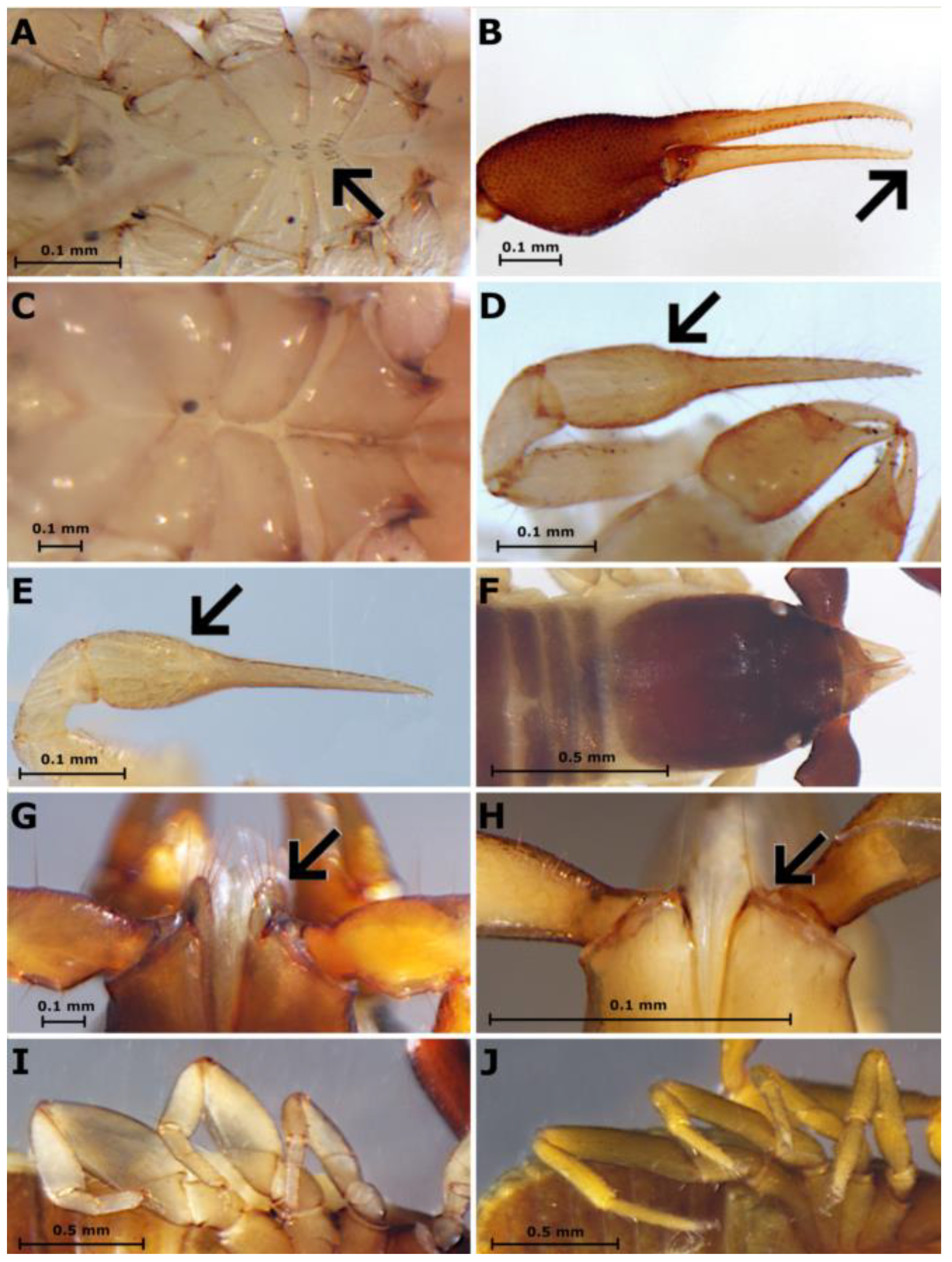
- 7. a. Arolia bifurcate (Figure 8A); several tergites and sternites are divided. . . . . . . . . . . . . . . . . . . . . . . . . . . . . . . . . . . . . . . . . . . . . . . . . . . . . . . . . . . . . . . superfamily Garypinoidea
- . . . . . . . . . . . . . . . . . . . . . . . . . . . . . . . . . . . . . . . . . . . . . . . . . . family Garypinidae (1, 2)
- . . . . . . . . . . . . . . . . . . . . . . . . . . . . . . . . . . . . . . . . . . . . . . . . . . . . . . . . . . . . . .Garypinus
- 7. b. Arolia simple (Figure 8B) (not bifurcate); tergites and sternites can (in certain families) be all undivided . . . . . . . . . . . . . . . . . . . . .superfamily Garypoidea. . . . . . . . . . . . . . . . 8
- 8. a. Venom apparatus present only in the fixed chelal finger; fixed chelal finger with 11 trichobothria, of which 2 are on the dorsal surface of the hand; specialised joint present between coxae II and III . . . . . . . . . . . . . . . . . . . . . . . . . . . . . . . .family Menthidae (1, 1)
- . . . . . . . . . . . . . . . . . . . . . . . . . . . . . . . . . . . . . . . . . . . . . . . . . . . . . . .Paramenthus shulovi
- 8. b. Venom apparatus present in both chelal fingers; fixed chelal finger with 8 or (rarely) 7 trichobothria, including 3 on the internal face; dorsal surface of the hand without trichobothria; articulation furrow between coxae II and III absent . . . . . . . . . . . . . . . . . . . . . . . . . . . . . . . . . . . . . . . . . . . . . . . . . . . . . . . . . . . . . . . . . . . . . . . . . . . . . . . . . . . . . . . . . . . . . .9
- 9. a. All tergites and sternites undivided (Figure 8C,D); abdomen oblong, not much broader than the carapace; the carapace sub-rectangular and slightly tapering orally; eyes positioned near the anterior margin of the carapace, not sitting on mounds; arolia longer than claws; vestitural bristles of pedipalps rather long, erect and thinly pointed; pleural membrane of abdomen with smooth and even longitudinal striation . . . . . . . . . . . . . . . . . . . . . . . . . .10
- 9. b. A few tergites and sternites are divided (Figure 8E); abdomen broadly oval, distinctly broader than the carapace; carapace triangular and strongly tapering orally; eyes protruding, sitting on mounds, removed from the anterior margin of the carapace; arolia can be longer or shorter than the claws; vestitural bristles of pedipalps very short, fine, bent and abruptly pointed; pleural membrane of abdomen granulate or with short wavy undulating striation . . . . . . . . . . . . . . . . . . . . . . . . . . . . . . . . . . . . . . . . . . . . . . . . . . . . . . . . . . . . . . 15
- 10. a. Palpal fingers distinctly bent; palpal femur with or without two fairly long dorsal tactile bristles . . . . . . . . . . . . . . . . . . . . . . . . . family Olpiidae (4, 10) . . . . . . . . . . . . . .11
- 10. b. Palpal fingers straight; palpal femur with a single fairly long dorsosubbasal tactile bristle . . . . . . . . . . . . . . . . . . . . . . . . . . . . . family Hesperolpiidae (2, 2) . . . . . . . . . . . 14
- 11. a. Carapace without submedian transverse furrow, longer than broad maximum 1.5 times . . . . . . . . . . . . . . . . . . . . . . . . . . . . . . . . . . . . . . . . . . . . . . . . . . . . . . . . . . . . . . . . 12
- 11. b. Carapace with a submedian transverse furrow; either just slightly or 1.7 to 1.8 times longer than broad . . . . . . . . . . . . . . . . . . . . . . . . . . . . . . . . . . . . . . . . . . . . . . . . . . . . . . .13
- 12. a. Carapace and pedipalps dark brown; palpal femur 0.6 to 0.7 mm long; fingers about as long as the hand with pedicel . . . . . . . . . . . . . . . . . . . . . . . . . . . . . . . . . . . . . . .Olpium
- 12. b. Carapace and pedipalps light yellowish-brown; palpal femur 0.9 to 1 mm long; fingers much longer than the hand with pedicel . . . . . . . . . . . . . . . . . . . . . . .Halominniza
- 13. a. Body length about 2 to 3 mm; carapace 1.7 to 1.8 times longer than broad; femur, tibia and chela of pedipalps dark brown, with pedicel and tips reddish, rarely entirely reddish; desert species with worm-shaped abdomen . . . . . . . . . . . . . . . . . . . . . . . . . . . . . Minniza
- 13. b. Body length 1.5 to 1.7 mm; carapace but slightly longer than broad; femur and tibia of pedipalps light brownish-yellow, chela blackish-olive brown . . . . . . . . . Calocheiridius
- 14. a. Body length 2.3 to 2.8 mm; eyes about half their diameter distant from one another; carapace with a weak transverse furrow; palpal hand very broad, abruptly constricted medially and laterally towards the base of the fingers; fingers at least as long as the femur; trichobothria est situated near the middle of fixed finger; three trichobothria ist, it and et form a group near tip of finger . . . . . . . . . . . . . . . . . . . . . . . . . . . . . . . .. . . . . Calocheirus
- 14. b. Body length 1.2 to 1.9 mm; eyes touching, the anterior eyes slightly excavated behind, the posterior eyes conical and flattened; carapace without a transverse furrow; palpal hand not very broad, medially obliquely narrowed towards the base of fingers; fingers shorter than femur; trichobothria est situated rather basally, proximal to the middle, near trichobothria isb, close to the group formed of eb-esb-ib-isb . . . . . . . . . . . . . . Cardiolpium
- 15. a. Carapace triangular and medially concave (Figure 8F); maxilla of palpal coxae with developed shoulder; coxal area not expanding posteriorly: coxa IV approximately the same width as coxa I (broad and short); body 2 to 2.5 mm long; arolia longer than the claws; tergites usually with dark spots; occur in leaf litter and under stones or bark in the Mediterranean shrubland . . . . . . . . . . . . . . . . . . . . . . . . . . . . . family Geogarypidae (1, 2)
- . . . . . . . . . . . . . . . . . . . . . . . . . . . . . . . . . . . . . . . . . . . . . . . . . . . . . . . . . . . . . .Geogarypus
- 15. b. Carapace triangular but not medially concave (Figure 8G); maxillar shoulder of palpal coxae not developed; coxal area expanding posteriorly: i.e., coxa IV distinctly longer and narrower than coxa I; body 5 to 6 mm long; arolia shorter than claws; tergites usually with dark bands; occur only in littoral or supralittoral zones . . . . . . . . . . . . . . . . . . . . . . . . . . . . . . . . . . . . . . . . . . . . . . . . . . . . . . . . . . . . . . . . . . . . . . . . . . . . . family Garypidae (1, 2)
- . . . . . . . . . . . . . . . . . . . . . . . . . . . . . . . . . . . . . . . . . . . . . . . . . . . . . . . . . . . . . . . .Garypus
- 16. a. Small body size (<2 mm); carapace triangular and coarsely granulate with one medial deep transverse furrow (Figure 8H); one pair of small eyes, if not absent, distinctly removed from the anterior margin; femur and patella of all legs fused, with suture between them hardly visible; coxa IV much wider than coxa I; pedipalps with a reduced number of trichobothria: at most seven on the fixed chelal finger and one or two on the moveable finger . . . . . . . . superfamily Cheiridioidea . . . . . . . . . . . . . . . family Cheiridiidae (1, 1) . . . . . . . . . . . . . . . . . . . . . . . . . . . . . . . . . . . . . . . . . . . . . . . . . . . . . . . . . . Apocheiridium
- 16. b. Body size larger than 1.5 mm; eyes (if not absent) positioned near the anterior margin of the carapace (Figure 8I); femur and patella of legs not fused; coxa IV not wider than coxa I; pedipalps usually with eight trichobothria on the fixed chelal finger and four on the moveable finger . . . . . . . . . . . . . . . . . . . . . superfamily Cheliferoidea . . . . . . . . .. . . . . 17
- 17. a. Venom apparatus present in both chelal fingers; one pair of eyes or eye spots; males with or without coxal sacs or ram’s horn organs . . . . . . . . . . . . . . . . . . . . . . . . . . . . . . .18
- 17. b. Venom apparatus absent from one chelal finger; no eyes or one pair of eyes or eye spots; males without coxal sacs or ram’s horn organs . . . . . . . . . . . . . . . . . . . . . . . . . . .22
- 18. a. Articulation of femur and patella of leg I and II narrow and transverse; therefore these joints are scarcely movable; male (and occasionally females) abdominal posterior sternites with discrete patches of glandular sensory setae; hind coxae of male without coxal sacks and ram’s horn organs absent; very small myrmecophilous specimens. . . . . . . . . . . . . . . . . . . . . . . . . . . . . . . . . . . . . . . . . . . . . . . . . . . . . . . . . . . . . . . . . family Withiidae (1, 1)
- . . . . . . . . . . . . . . . . . . . . . . . . . . . . . . . . . . . . . . . . . . . . . . . . . . .Nannowithius wahrmani
- 18. b. Articulation of femur and patella of leg I and II well developed (Figure 8J), great and oblique and therefore well movable; male abdominal sternites without patches of sensory setae; hind coxae of male excavate caudally, male genitalia with coxal sacks and ram’s horn shaped organs (Figure 8J); not myrmecophilous . . . . . . . . . . . . . . . . . . . . . . . . . . . . . . . . . . . . . . . . . . . . . . . . . . . . . . . . . . . . . . family Cheliferidae (4, 18) . . . . . . . . . . . . . . . . . . . .19
- 19. a. Carapace with dense granulation and greater bristle-bearing granules; abdominal tergites of male with lateral carinae and elongated hind-angles . . . . . . . . . . . . . . . . . . . . .20
- 19. b. Carapace with dense granulation without greater granules; abdominal tergites of male without lateral carinae, their hind-angles are not elongated . . . . . . . . . . . . . . . . . . . 21
- 20. a. Pedipalpal femur with coarse bristle-bearing medial granules; subbasal bristle of chelicera present . . . . . . . . . . . . . . . . . . . . . . . . . . . . . . . . . . . . . . . . . . . . . .Hysterochelifer
- 20. b. Pedipalpal femur without coarse medial granules; no subbasal bristle of chelicera . . . . . . . . . . . . . . . . . . . . . . . . . . . . . . . . . . . . . . . . . . . . . . . . . . . . . . . . . . . . . . . . . . . . Chelifer
- 21. a. At least submedian transverse furrow of the carapace deeply incised; pedipalps slender . . . . . . . . . . . . . . . . . . . . . . . . . . . . . . . . . . . . . . . . . . . . . . . . . . . . .Dactylochelifer
- 21. b. Both transverse furrows of carapace shallow; pedipalps clumsy and strong . . . . . . . . . . . . . . . . . . . . . . . . . . . . . . . . . . . . . . . . . . . . . . . . . . . . . . . . . . . . . . . . . . . .Rhacochelifer
- 22. b. One pair of eyes or eye spots; venom apparatus developed only in fixed chelal finger; longitudinal grooves may be present; slender and elongate abdomen, not broader than the carapace . . . . . . . . . . . . . . . . . . . . . . . . . . . . . . . . . . . . . . . . . . . . family Atemnidae (1, 2)
- . . . . . . . . . . . . . . . . . . . . . . . . . . . . . . . . . . . . . . . . . . . . . . . . . . . . . . . . . . . . . . . . .Atemnus
- 23. a. Body and pedipalp setae long, thin and pointed; carapace almost smooth; subbasal transverse furrow on carapace indistinct; tibia and hand of pedipalps with fairly long lateral pseudotactile setae; often phoretic on flies . . . . . . . . . . . . . . . . . . . . . Lamprochernes
- 23. b. Body and pedipalp setae short, stout, dentate or clavate; carapace granulate; tibia and hand of pedipalps without lateral pseudotactile setae; not phoretic on flies . . . . . . .24
- 24. a. Tarsus of leg IV with long erect tactile seta near the middle, distinctly longer than the width of the tarsus . . . . . . . . . . . . . . . . . . . . . . . . . . . . . . . . . . . . . . . . . . . . . . . . . . . . . .25
- 24. b. Tarsus of leg IV without erect tactile seta near the middle . . . . . . . . . . . . . . . . . . .27
- 25. a. Carapace rather coarsely granulated, with two distinct transverse furrows, of which the posterior is flatter than the anterior; body and pedipalp setae always slightly but clearly clavate, relatively long; male pedipalp without dense long setation; palpal femur at most 0.5 mm long; small 1.5–2 mm; in ground litter and detritus, in moist places . . . . . . . . . . . . . . . . . . . . . . . . . . . . . . . . . . . . . . . . . . . . . . . . . . . . . . . . . . . . . . . . . . . . . . . .Pselaphochernes
- 25. b. Carapace with dense and fine granulation with a posterior transverse furrow situated scarcely nearer to the hind border than to the anterior furrow; body setae dentate but not clavate; palpal femur longer than 0.7 mm; body length 2-4mm; in nests of small mammals and in caves with bats . . . . . . . . . . . . . . . . . . . . . . . . . . . . . . . . . . . . . . . . . . . . . . . . . . . 26
- 26. a. Tactile bristle near the middle of the hind tarsus long and simple; body setae rather long and serrated to slightly truncate not clavate, those of the pedipalps only serrated; setae on the femur and tibia of the pedipalps of the male very long and dense like a mane; fairly large and robust: body length 4 mm, palpal femur at least 1 mm long; in nests of Apodemus . . . . . . . . . . . . . . . . . . . . . . . . . . . . . . . . . . . . . . . . . . . . . . . . . . . . . . . . .. . . . . Lasiochernes
- 26. b. Tactile bristle near the middle of the hind tarsus dentate and scarcely twice as long as the other bristles and about one third as long as the width of the tarsus; body setae very short; medial bristles of the palpal femur of the male but scarcely more dense than in the female; body length 2-3 mm, femur length 0.69-0.74 mm; in nests of the rodent Nannospalax . . . . . . . . . . . . . . . . . . . . . . . . . . . . . . . . . . . . . . . . . . . . . . . . . . . . . . . . . . . . Nudochernes
- 27. a. Carapace quite coarsely granulated; body and pedipalp setae serrated and strongly culled usually quite short; slightly clavate; pedipalps are moderately slender, granulated . . . . . . . . . . . . . . . . . . . . . . . . . . . . . . . . . . . . . . . . . . . . . . . . . . . . . . . . . . . . . . . Allochernes
- 27. b. Carapace moderately coarsely granulated, sometimes partially reticulated; body and pedipalp setae dentate and more or less truncate; pedipalps robust, granulated; pedipalp coxae usually not granulated . . . . . . . . . . . . . . . . . . . . . . . . . . . . . . . . . . . . . . . . . . Chernes
3.2. Ecology and Distribution
3.2.1. Biogeography and Biodiversity
3.2.2. Seasonality, Habitat, and Collection Methodology
4. Discussion
4.1. Distribution and Zoogeography
4.2. Endemism
4.3. Seasonality
4.4. Habitats and Collection Methods
Supplementary Materials
Author Contributions
Funding
Data Availability Statement
Acknowledgments
Conflicts of Interest
References
- WPC–World Pseudoscorpiones Catalog. Natural History Museum Bern. Available online: https://wac.nmbe.ch/order/pseudoscorpiones/3 (accessed on 12 May 2023).
- Vitali-di Castri, V. Biogeography of Pseudoscorpions in the Mediterranean regions of the world. In Mediterranean Type Ecosystems: Origin and Structure; di Castri, F., Mooney, H.A., Eds.; Ecological Studies; Springer: Berlin/Heidelberg, Germany, 1973; Volume 7, pp. 295–305. [Google Scholar]
- Liebke, D.F.; Harms, D.; Widyastuti, R.; Scheu, S.; Potapov, A.M. Impact of rainforest conversion into monoculture plantation systems on pseudoscorpion density, diversity and trophic niches. Soil Org. 2021, 93, 83–96. [Google Scholar]
- Blondel, J.; Aronson, J.; Bodiou, J.Y.; Boeuf, G. The Mediterranean Region: Biological Diversity in Space and Time; Oxford University Press: Oxford, UK, 2010. [Google Scholar]
- Harvey, M.S. The smaller arachnid orders: Diversity, descriptions and distributions from Linnaeus to the present (1758 to 2007). Zootaxa 2007, 1668, 363–380. [Google Scholar] [CrossRef]
- Hlebec, D.; Podnar, M.; Kučinić, M.; Harms, D. Molecular analyses of pseudoscorpions in a subterranean biodiversity hotspot reveal cryptic diversity and microendemism. Sci. Rep. 2023, 13, 430–444. [Google Scholar] [CrossRef]
- Kloog, I.; Sorek-Hamer, M.; Lyapustin, A.; Coull, B.; Wang, Y.; Just, A.C.; Schwartz, J.; Broday, D.M. Estimating daily PM2.5 and PM10 across the complex geo-climate region of Israel using MAIAC satellite-based AOD data. Atmos. Environ. 2015, 122, 409–416. [Google Scholar] [CrossRef]
- Goldreich, Y. Climate regions and seasons in Israel. In The Climate of Israel: Observation, Research and Application; Springer: Boston, MA, USA, 2003; pp. 12–22. [Google Scholar]
- Israel Meteorological Service (IMS): Map of Annual Mean Precipitation Israel (1991–2020) Climate Atlas of Israel. Available online: https://ims.gov.il/en/ClimateAtlas (accessed on 10 February 2023).
- Zonstein, S.; Marusik, Y.M. Checklist of the spiders (Araneae) of Israel. Zootaxa 2013, 3671, 1–127. [Google Scholar] [CrossRef]
- Aharon, S.; Ballesteros, J.A.; Crawford, A.R.; Friske, K.; Gainett, G.; Langford, B.; Santibáñez-López, C.E.; Ya’aran, S.; Gavish-Regev, E.; Sharma, P.P. The anatomy of an unstable node: A Levantine relict precipitates phylogenomic dissolution of higher-level relationships of the armoured harvestmen (Arachnida: Opiliones: Laniatores). Invertebr. Syst. 2019, 33, 697–717. [Google Scholar] [CrossRef]
- Aharon, S.; Ballesteros, J.A.; Gainett, G.; Hawlena, D.; Sharma, P.P.; Gavish-Regev, E. In the land of the blind: Exceptional subterranean speciation of cryptic troglobitic spiders of the genus Tegenaria (Araneae: Agelenidae) in Israel. Mol. Phylogenetics Evol. 2023, 183, 107705. [Google Scholar] [CrossRef]
- Ćurčić, B.P.M. Ayyalonia dimentmani, n. g., n. sp. (Ayyaloniini n. trib., Chthoniidae, Pseudoscorpiones) from a cave in Israel. Arch. Biol. Sci. Belgrade 2008, 60, 331–339. [Google Scholar] [CrossRef]
- Gavish-Regev, E.; Aharon, S.; Armiach Steinpress, I.; Seifan, M.; Lubin, Y. A Primer on Spider Assemblages in Levantine Caves: The Neglected Subterranean Habitats of the Levant—A Biodiversity Mine. Diversity 2021, 13, 179. [Google Scholar] [CrossRef]
- Beier, M. Die Pseudoscorpioniden-Fauna Israels und einiger angrenzender Gebiete. Isr. J. Ecol. Evol. 1963, 12, 183–212. [Google Scholar]
- Mahnert, V. Einige Pseudoskorpione aus Israel. Rev. Suisse Zool. 1974, 81, 377–386. [Google Scholar] [CrossRef]
- Halperin, J.; Mahnert, V. On some bark-inhabiting pseudoscorpiones (Arachnida) from Israel. Isr. J. Entomol. 1987, 21, 127–128. [Google Scholar]
- Harvey, M.S. Pseudoscorpionsof the World; Version 3.0; Western Australian Museum: Perth, Australia, 2013. Available online: https://museum.wa.gov.au/catalogues-beta/pseudoscorpions (accessed on 12 May 2023).
- Benavides, L.R.; Cosgrove, J.G.; Harvey, M.S.; Giribet, G. Phylogenomic interrogation resolves the backbone of the Pseudoscorpiones tree of life. Mol. Phylogenetics Evol. 2019, 139, 106509. [Google Scholar] [CrossRef]
- Salman, I.N.; Ferrante, M.; Möller, D.M.; Gavish-Regev, E.; Lubin, Y. Trunk refugia: A simple, inexpensive method for sampling tree trunk arthropods. J. Insect Sci. 2020, 20, 5. [Google Scholar] [CrossRef]
- Klein, M. The geomorphology of Israel. In The Zoogeography of Israel—The Distribution and Abundance at a Zoogeographical Crossroad; Yom-Tov, Y., Tchernov, E., Eds.; Dr W. Junk Publishers: Dordrecht, The Netherlands; Boston, MA, USA; Lancaster, UK, 1988; pp. 59–78. [Google Scholar]
- Vigna Taglianti, A.; Audisio, P.A.; Biondi, M.; Bologna, M.A.; Carpaneto, G.M.; De Biase, A.; Fattorini, S.; Piattella, E.; Sindaco, R.; Venchi, A.; et al. A proposal for a chorotype classification of the Near East fauna, in the framework of the Western Palearctic region. Biogeogr. J. Integr. Biogeogr. 1999, 20, 31–59. [Google Scholar] [CrossRef]
- Ćurčić, N.B.; Dimitrijević, R.N.; Ćurčić, S.B. Checklist of the pseudoscorpions (Arachnida: Pseudoscorpiones) of Serbia. Arthropoda Selecta. Pyccкuй Apтpoпoдoлoгичecкий Жуpнал 2020, 29, 13–27. [Google Scholar] [CrossRef]
- Elverici, M. Impact of Olive Grove Management on Spider (Araneae) Community in Northwestern Turkey. Ph.D. Thesis, Middle East Technical University, Ankara, Turkey, 2018. [Google Scholar]
- Komnenov, M. Spider fauna of the Osogovo Mt. Range, Northeastern Macedonia. Fauna Balk. 2014, 2, 1–267. [Google Scholar]
- Beier, M. Die Pseudoskorpione des Wiener Naturhistorischen Museums. II. Panctenodactyli. Ann. Naturhistorischen Mus. Wien 1929, 43, 341–367. [Google Scholar]
- Beier, M. Über Pseudoscorpione aus Syrien und Palästina. Ann. Naturhistorischen Mus. Wien 1955, 60, 212–219. [Google Scholar]
- Šťáhlavský, F.; Král, J.; Harvey, M.S.; Haddad, C.R. A karyotype study on the pseudoscorpion families Geogarypidae, Garypinidae and Olpiidae (Arachnida: Pseudoscorpiones). Eur. J. Entomol. 2006, 103, 277–289. [Google Scholar] [CrossRef]
- Zvik, Y. First record of myrmecophyly in the scorpion Birulatus israelensis (Scorpiones: Buthidae). Arachnol. Mitteilungen 2017, 54, 21–23. [Google Scholar] [CrossRef]
- Beron, P. Regional Arachnogeography. In Zoogeography of Arachnida; Springer: Cham, Switzerland, 2018; pp. 319–624. [Google Scholar]
- Por, F.D. An outline of the zoogeography of the Levant. Zool. Scr. 1975, 4, 5–20. [Google Scholar] [CrossRef]
- Christophoryová, J.; Gruľa, D.; Krajčovičová, K. New records of pseudoscorpions (Arachnida: Pseudoscorpiones) associated with animals and human habitats in Slovakia and the Czech Republic. Arachnol. Mitteilungen 2017, 53, 67–76. [Google Scholar] [CrossRef]
- Christophoryová, J.; Gruľa, D.; Jablonski, D. First record of the genus Lamprochernes (Pseudoscorpiones: Chernetidae) in Albania. Biharean Biol. 2017, 11, 62–64. [Google Scholar]
- Beron, P. Arachnogeographical comparison between West Palearctic and Afrotropical Areas. Ecol. Montenegrina 2016, 7, 464–506. [Google Scholar] [CrossRef]
- Sharma, P.P.; Prieto, C.E.; Giribet, G. A new family of Laniatores (Arachnida: Opiliones) from the Afrotropics. Invertebr. Syst. 2011, 25, 143–154. [Google Scholar] [CrossRef]
- Mahnert, V. Die Pseudoskorpione (Arachnida) Kenyas. Familien Withiidae und Cheliferidae. Trop. Zool. 1988, 1, 39–89. [Google Scholar] [CrossRef][Green Version]
- Borowiec, L.; Salata, S. Review of ants (Hymenoptera: Formicidae) from Jordan. Ann. Up. Silesian Mus. Bytom Entomol. 2020, 29, 1–26. [Google Scholar]
- Harvey, M.S. A review of the taxonomy and biology of pseudoscorpions of Nannowithius and Termitowithius (Pseudoscorpiones, Withiidae), inquilines of social insects. J. Arachnol. 2015, 43, 342–352. [Google Scholar] [CrossRef]
- Mahnert, V. Pseudoscorpions (Arachnida: Pseudoscorpiones) of the Socotra Archipelago, Yemen. Fauna Arab. 2007, 23, 271–307. [Google Scholar]
- Nassirkhani, M.; Vafai Shoushtari, R. The first record of the family Menthidae Chamberlin (Arachnida: Pseudoscorpiones) from Iran. Int. J. Res. Stud. Zool. 2015, 1, 27–31. [Google Scholar]
- Kunt, K.B.; Bayram, A.; Yağmur, E.A.; Danışman, T. Checklist of the pseudoscorpions of Turkey (Pseudoscorpionida; Arachnida). Turk. J. Arachnol. 2008, 1, 70–84. [Google Scholar]
- Legakis, A.; Adamopoulou, C. Temporal responses of soil invertebrate communities to drought stress in two semiarid ecosystems of the Mediterranean. Isr. J. Zool. 2005, 51, 331–348. [Google Scholar] [CrossRef]
- Broza, M.; Poliakov, D.; Conde, B. The first record of the order Palpigradida (Arachnida) in Israel and the occurrence of arachnids in soils of Mediterranean pine forests. Isr. J. Zool. 1993, 39, 147–151. [Google Scholar]
- Bedoya-Roqueme, E.; Tizo-Pedroso, E. Techniques for collection and sampling of pseudoscorpions (Arthropoda: Arachnida). In Measuring Arthropod Biodiversity; Springer: Cham, Switzerland, 2021; pp. 341–363. [Google Scholar]
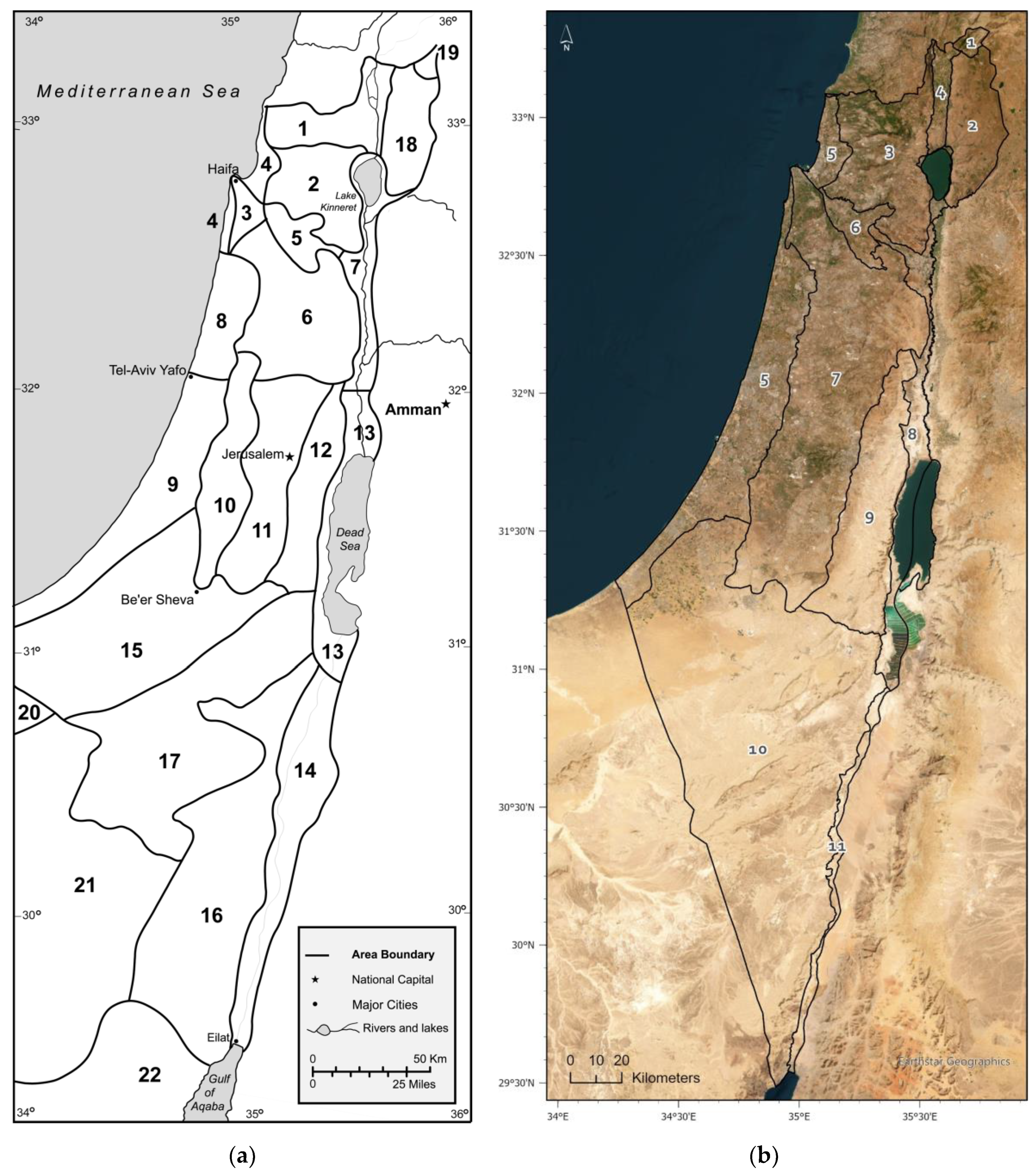
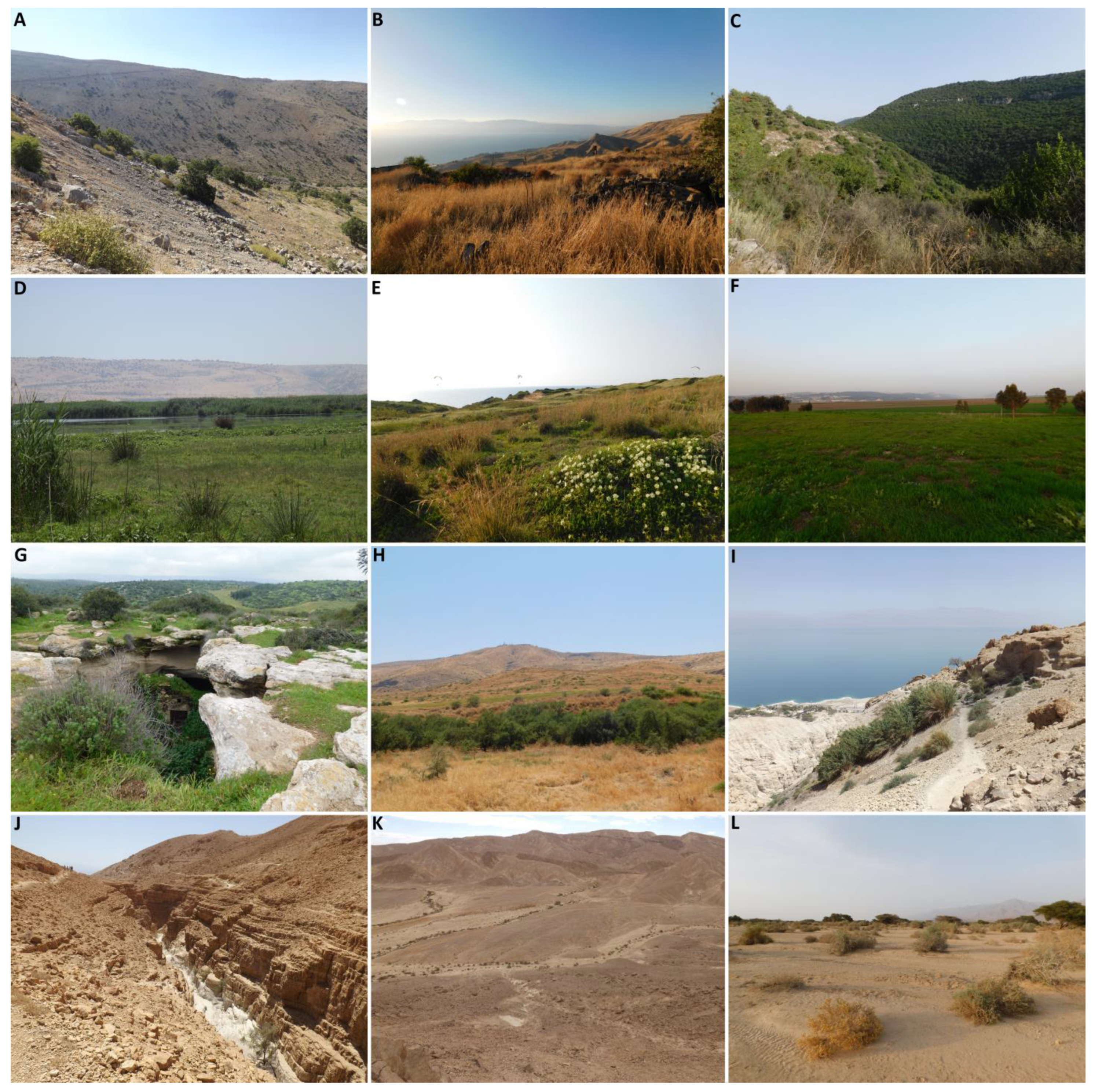
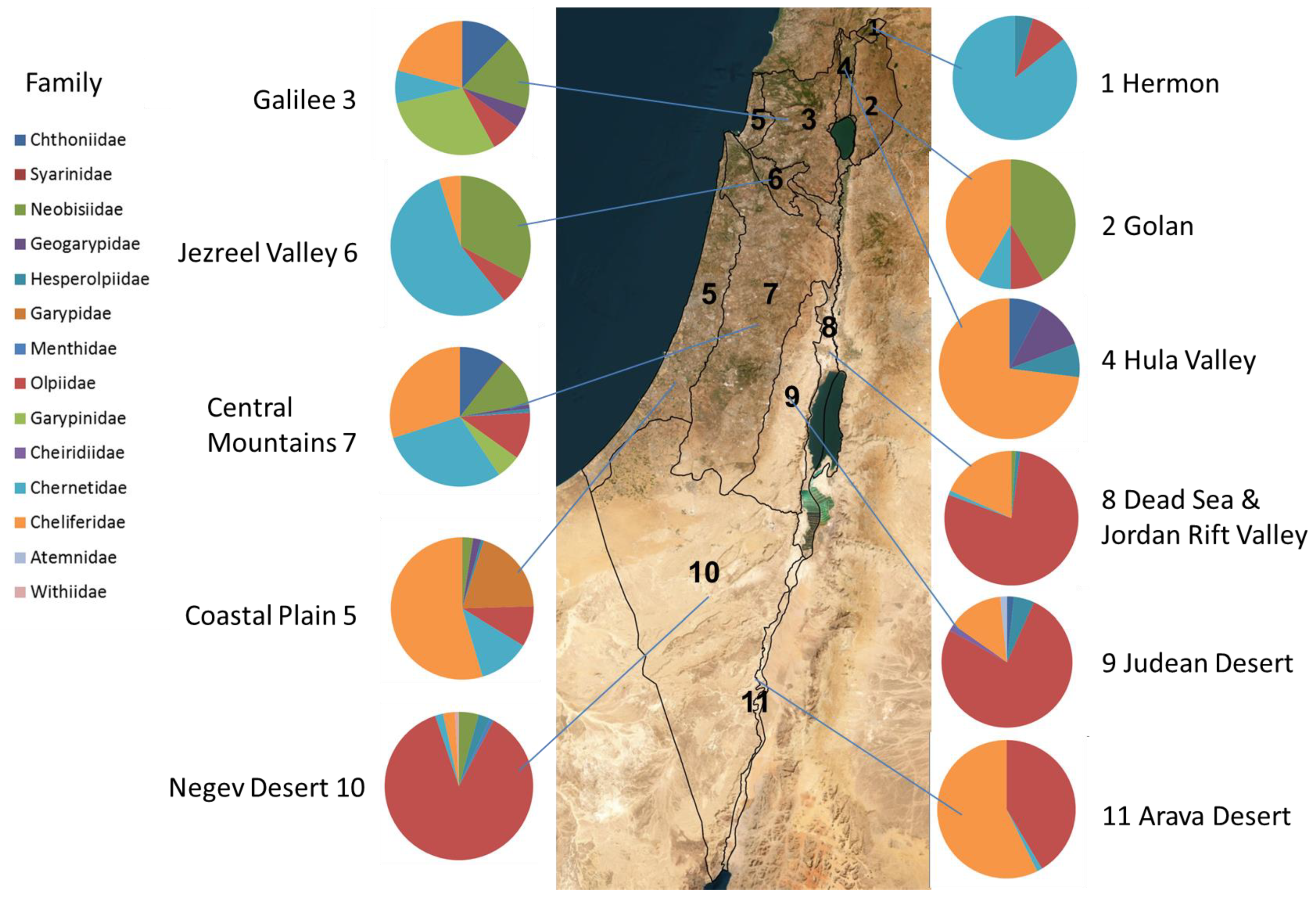
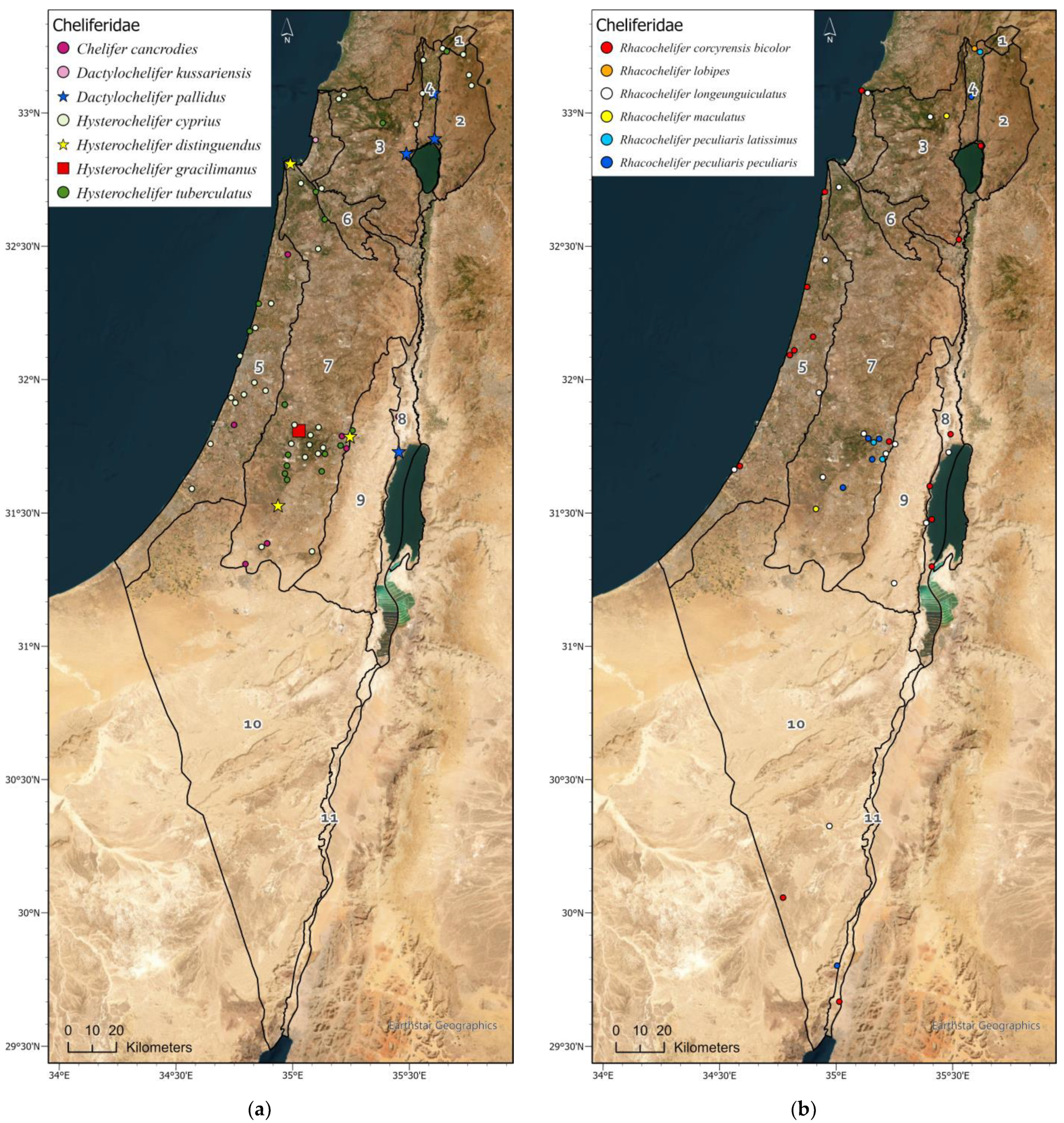
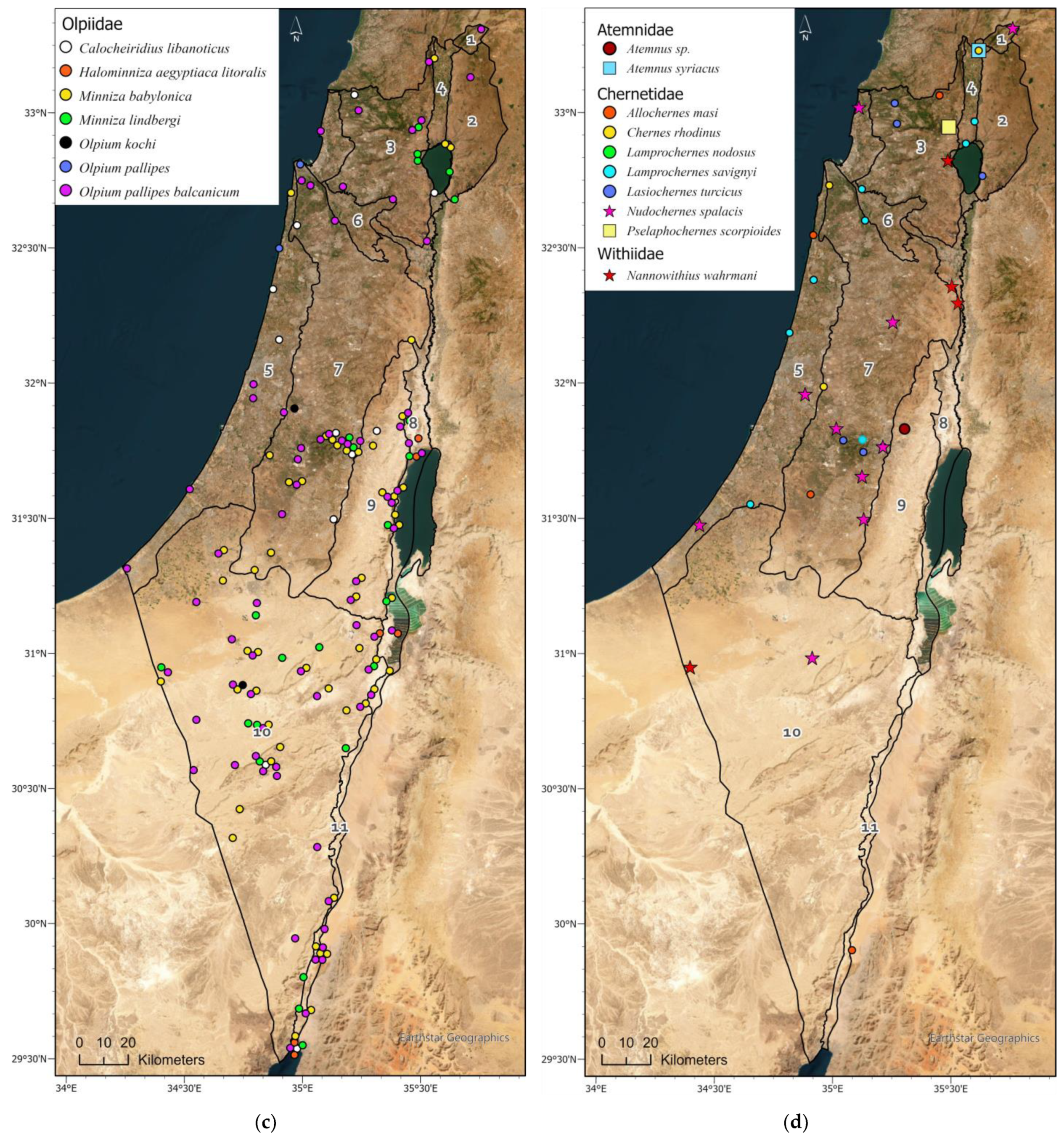
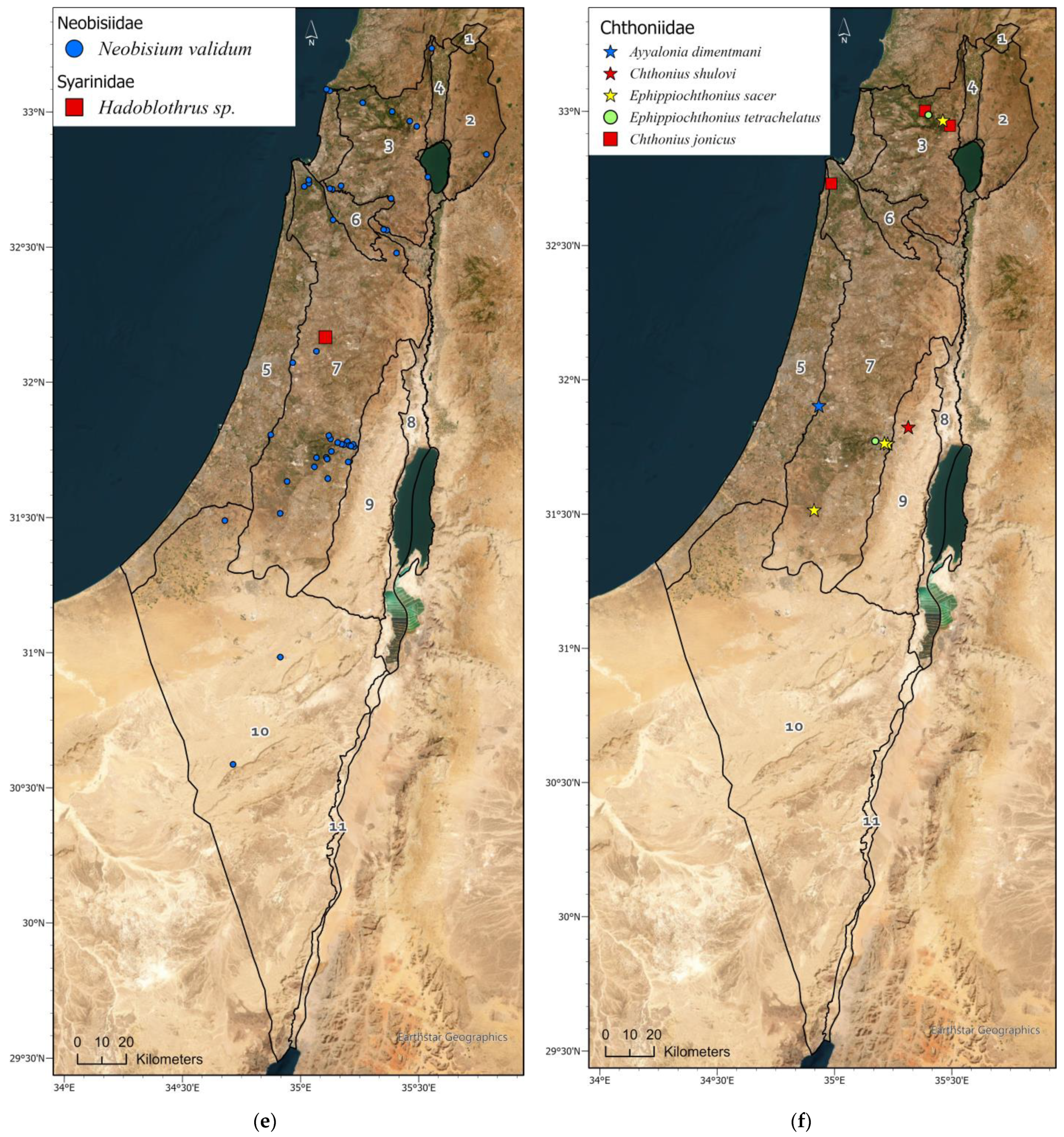
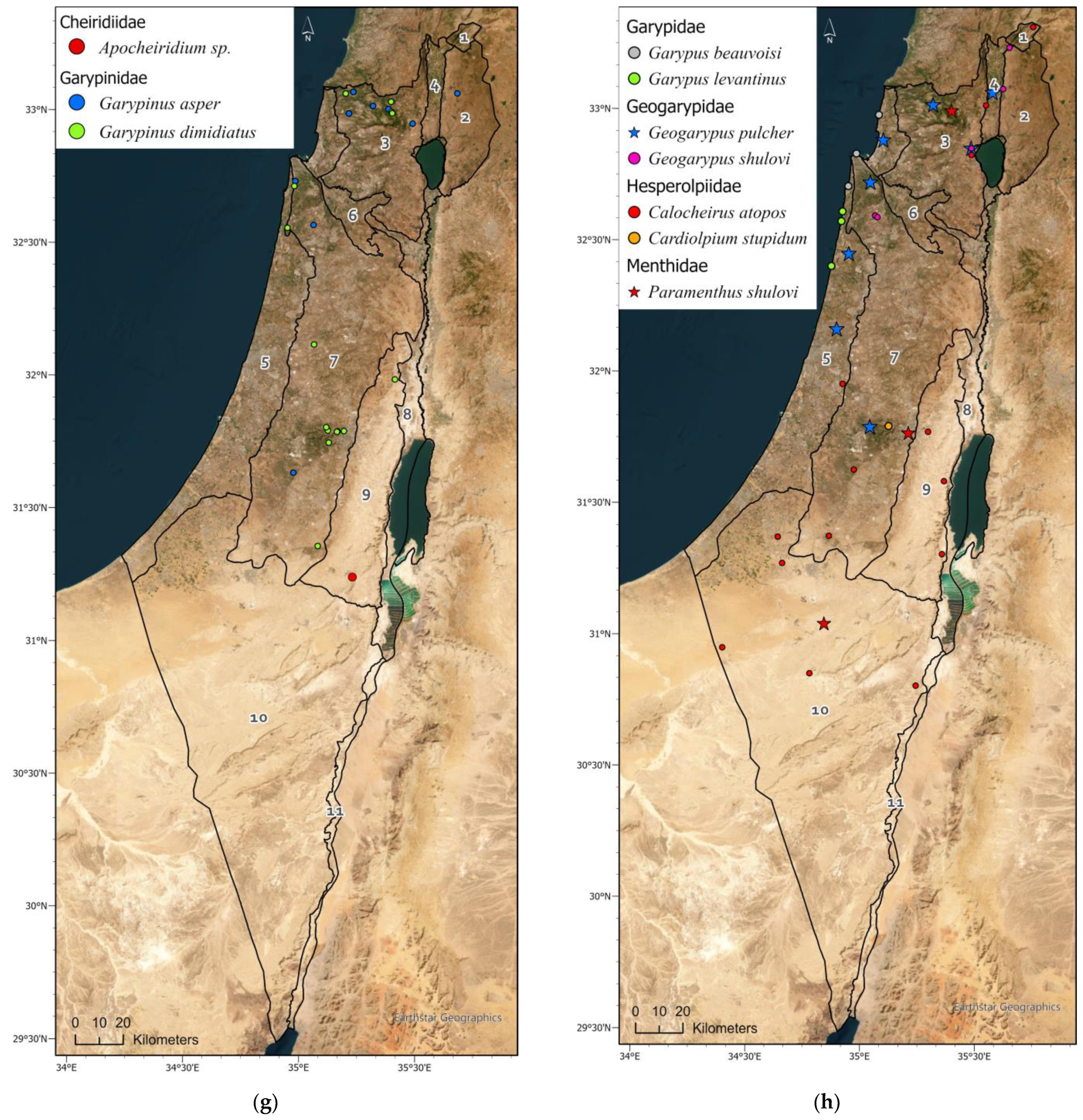
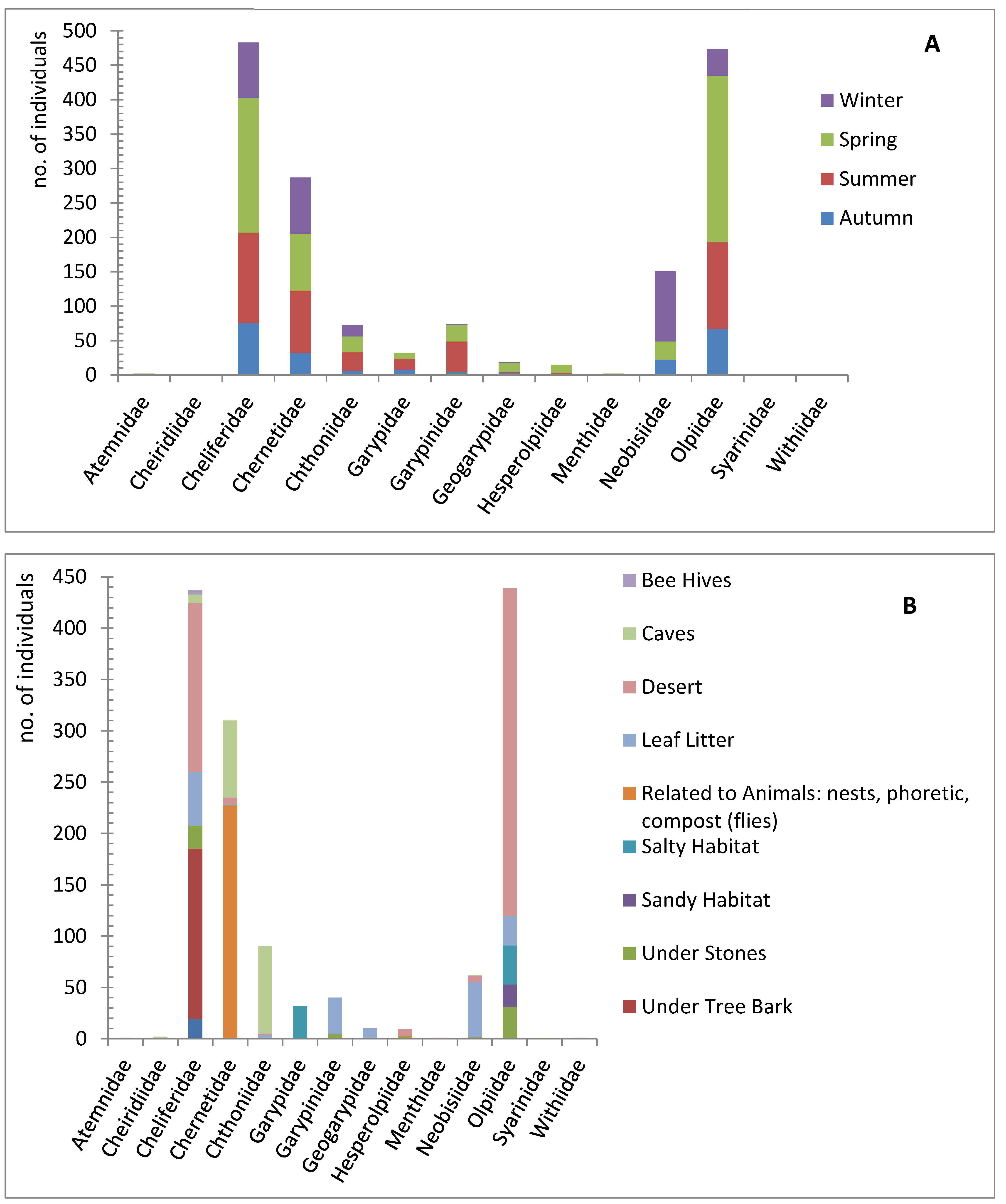
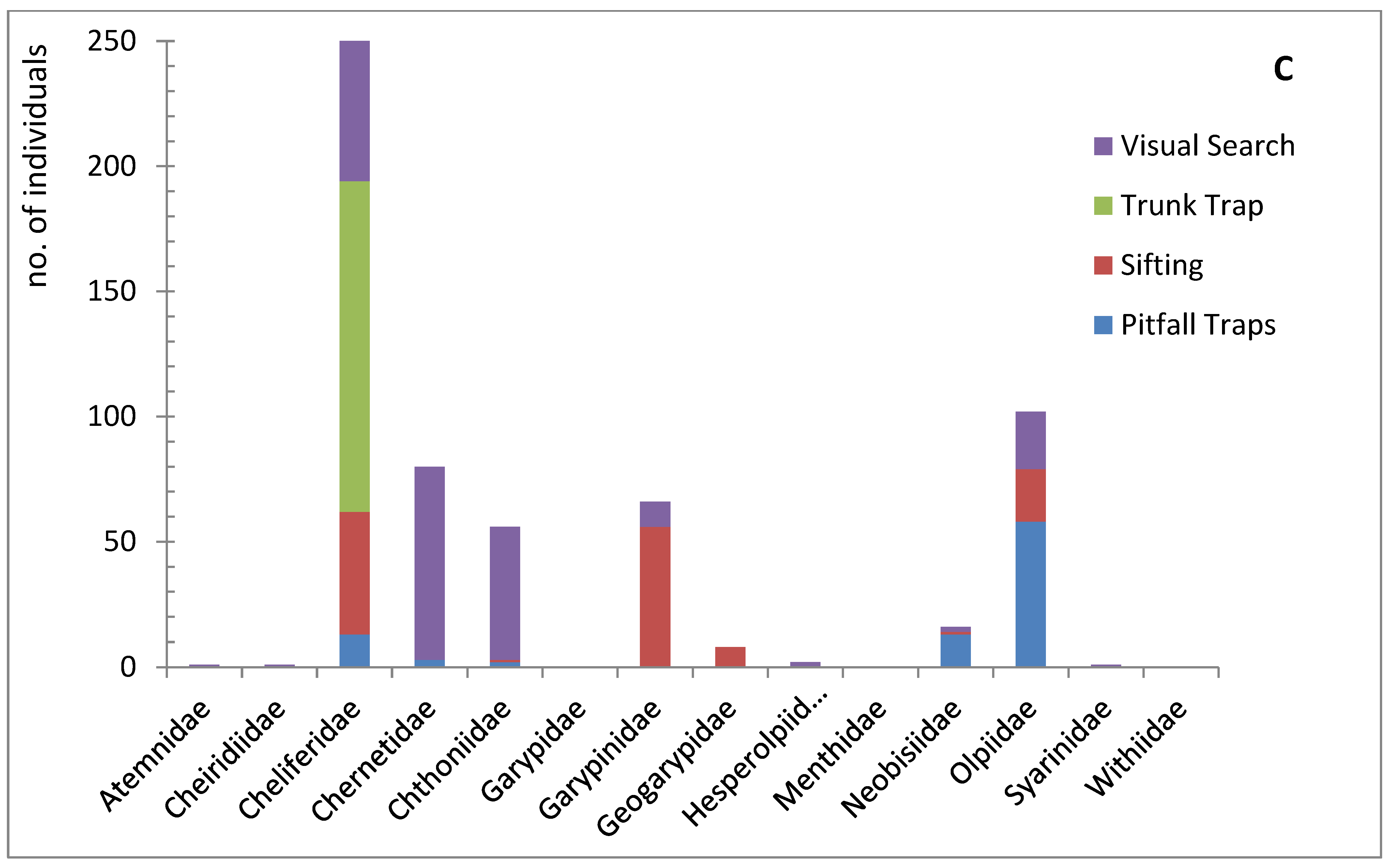
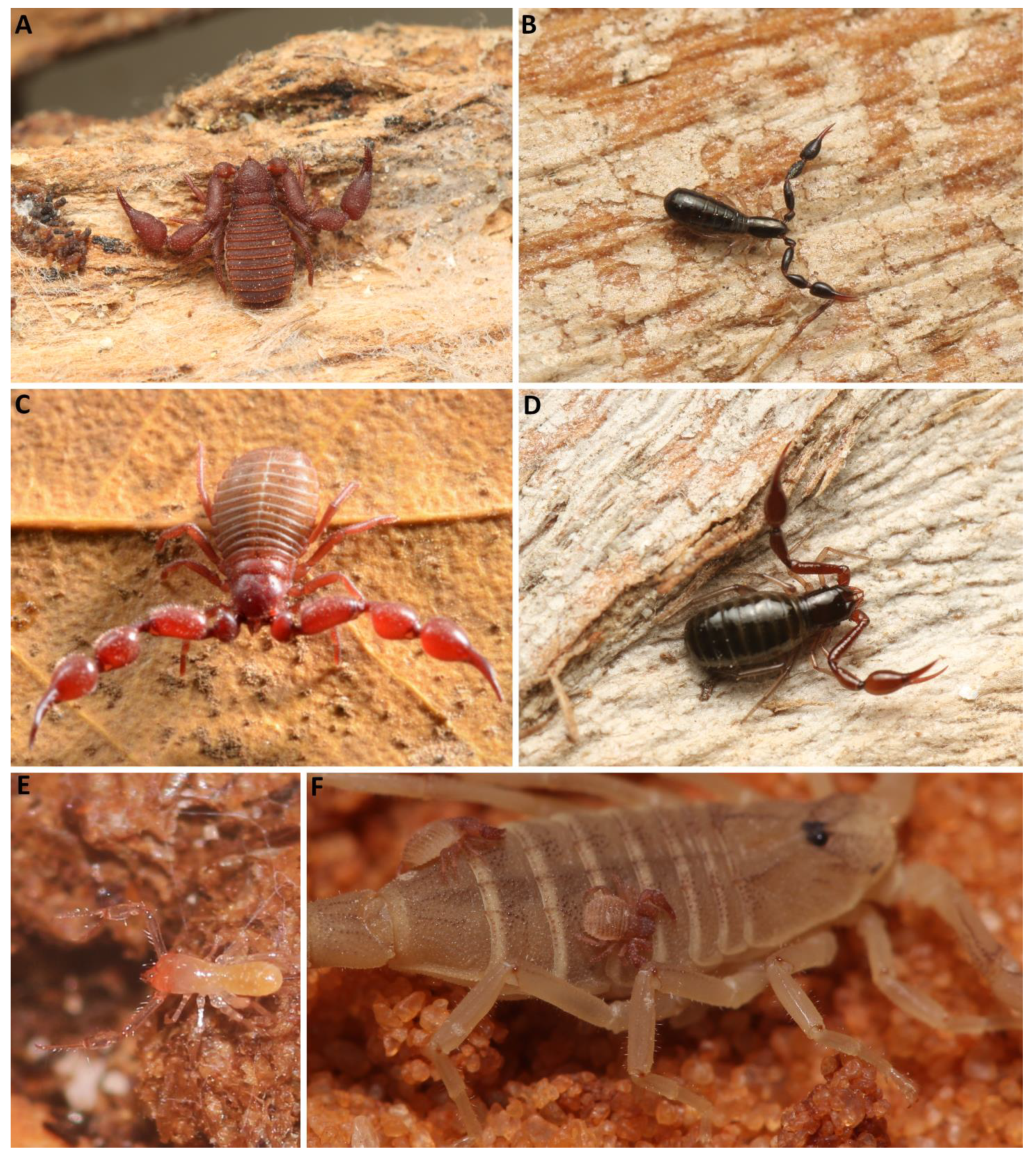
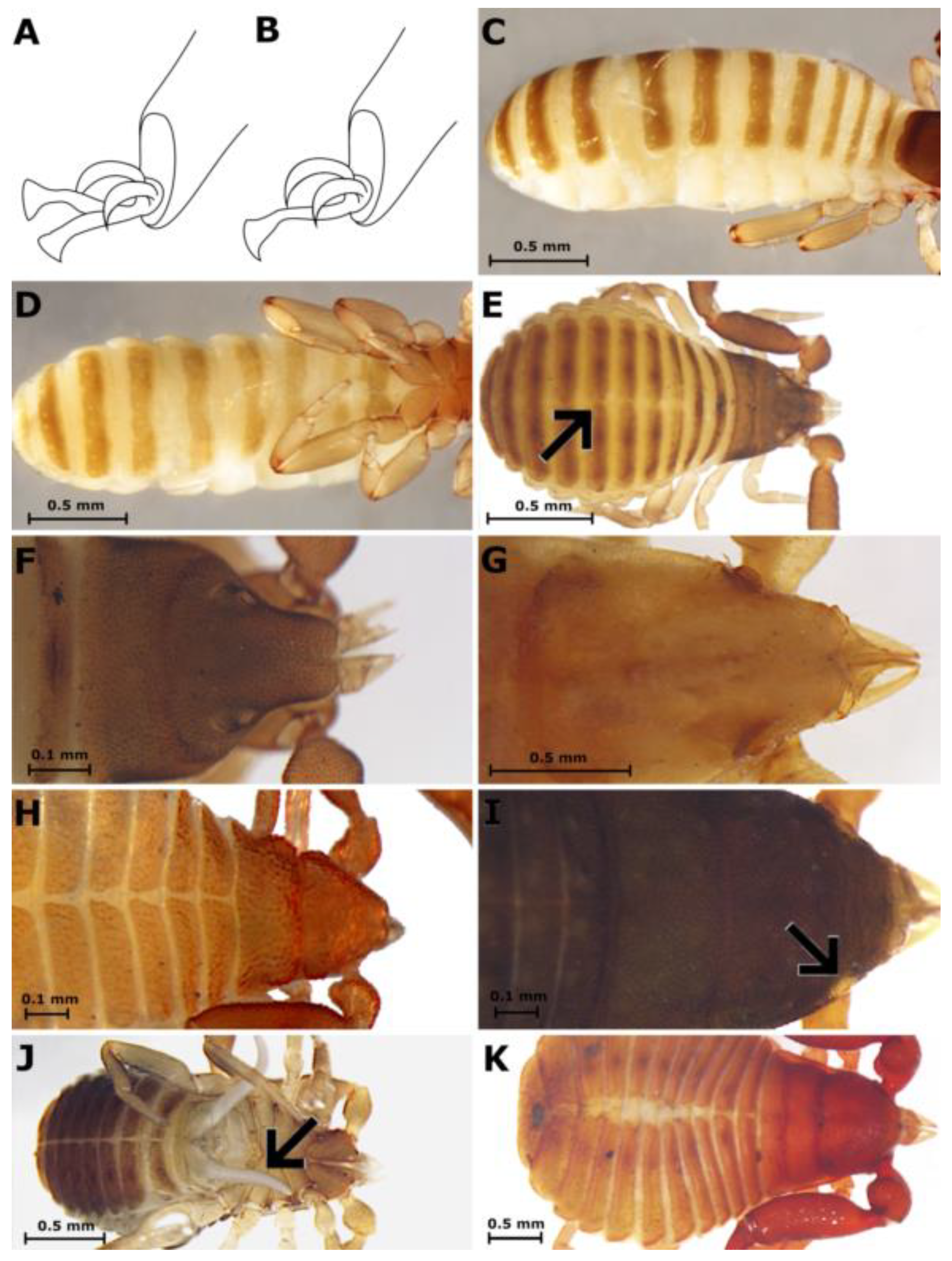
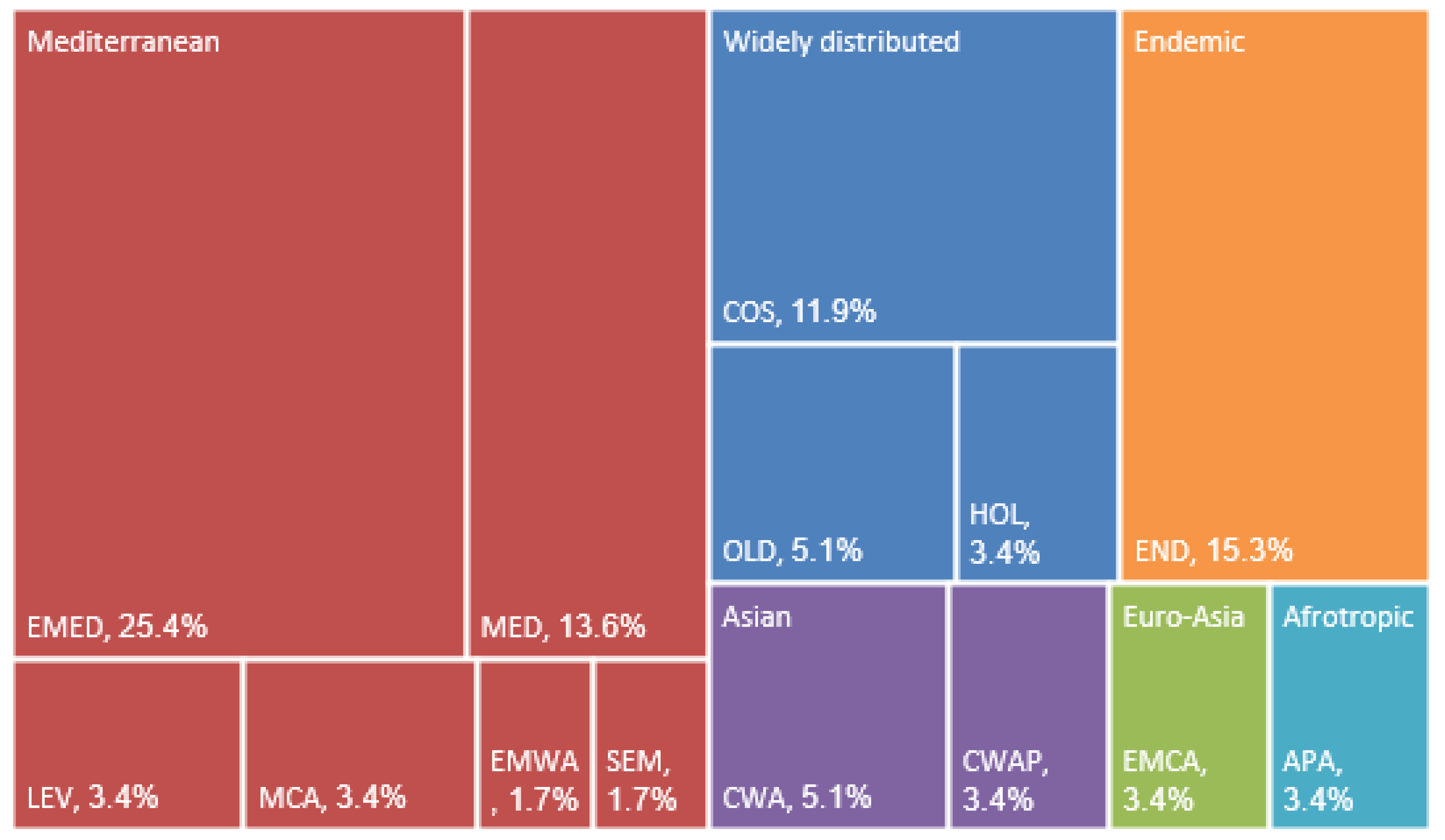
| Chorological Complex | Chorotype Classification | Code |
|---|---|---|
| Widely distributed | Cosmopolitan | COS |
| Holarctic | HOL | |
| Old World | OLD | |
| Mediterranean | Circum-Mediterranean | MED |
| East Mediterranean | EMED | |
| Levant | LEV | |
| East-Mediterranean and Western Asia | EMWA | |
| Mediterranean and Central Asia | MCA | |
| South-European and Mediterranean | SEM | |
| Euro-Asia | East-Mediterranean and Central and Western Asia | EMCA |
| Asian | Central and Western Asia | CWA |
| Central and Western Asia and Arabian Peninsula | CWAP | |
| Afrotropic | Arabian Peninsula and Africa | APA |
| Endemic | Endemic to Israel | END |
| Suborder | Infraorder | Superfamily | Family | No. of Genera | No. of Species | |
|---|---|---|---|---|---|---|
| Valid | Putative | |||||
| HETEROSPHYRONIDA | Chthonioidea | Chthoniidae | 3 | 5 | 2 | |
| IOCHEIRATA | Hemictenata | Neobisioidea | Syarinidae | 1 | 1 | |
| Neobisiidae | 1 | 1 | 2 | |||
| Panctenata | Garypoidea | Geogarypidae | 1 | 2 | ||
| Hesperolpiidae | 2 | 2 | ||||
| Garypidae | 1 | 2 | ||||
| Menthidae | 1 | 1 | ||||
| Olpiidae | 4 | 10 | ||||
| Garypinoidea | Garypinidae | 1 | 2 | |||
| Cheiridioidea | Cheiridiidae | 1 | 1 | |||
| Cheliferoidea | Chernetidae | 6 | 8 | 1 | ||
| Cheliferidae | 4 | 18 | ||||
| Atemnidae | 1 | 1 | 1 | |||
| Withiidae | 1 | 1 | ||||
Disclaimer/Publisher’s Note: The statements, opinions and data contained in all publications are solely those of the individual author(s) and contributor(s) and not of MDPI and/or the editor(s). MDPI and/or the editor(s) disclaim responsibility for any injury to people or property resulting from any ideas, methods, instructions or products referred to in the content. |
© 2023 by the authors. Licensee MDPI, Basel, Switzerland. This article is an open access article distributed under the terms and conditions of the Creative Commons Attribution (CC BY) license (https://creativecommons.org/licenses/by/4.0/).
Share and Cite
Warburg, S.; Aharon, S.; Armiach Steinpress, I.; Sharma, P.P.; Harms, D.; Gavish-Regev, E. Pseudoscorpions of Israel: Annotated Checklist and Key, with New Records of Two Families (Arachnida: Pseudoscorpiones). Taxonomy 2023, 3, 466-495. https://doi.org/10.3390/taxonomy3040027
Warburg S, Aharon S, Armiach Steinpress I, Sharma PP, Harms D, Gavish-Regev E. Pseudoscorpions of Israel: Annotated Checklist and Key, with New Records of Two Families (Arachnida: Pseudoscorpiones). Taxonomy. 2023; 3(4):466-495. https://doi.org/10.3390/taxonomy3040027
Chicago/Turabian StyleWarburg, Sharon, Shlomi Aharon, Igor Armiach Steinpress, Prashant P. Sharma, Danilo Harms, and Efrat Gavish-Regev. 2023. "Pseudoscorpions of Israel: Annotated Checklist and Key, with New Records of Two Families (Arachnida: Pseudoscorpiones)" Taxonomy 3, no. 4: 466-495. https://doi.org/10.3390/taxonomy3040027
APA StyleWarburg, S., Aharon, S., Armiach Steinpress, I., Sharma, P. P., Harms, D., & Gavish-Regev, E. (2023). Pseudoscorpions of Israel: Annotated Checklist and Key, with New Records of Two Families (Arachnida: Pseudoscorpiones). Taxonomy, 3(4), 466-495. https://doi.org/10.3390/taxonomy3040027






